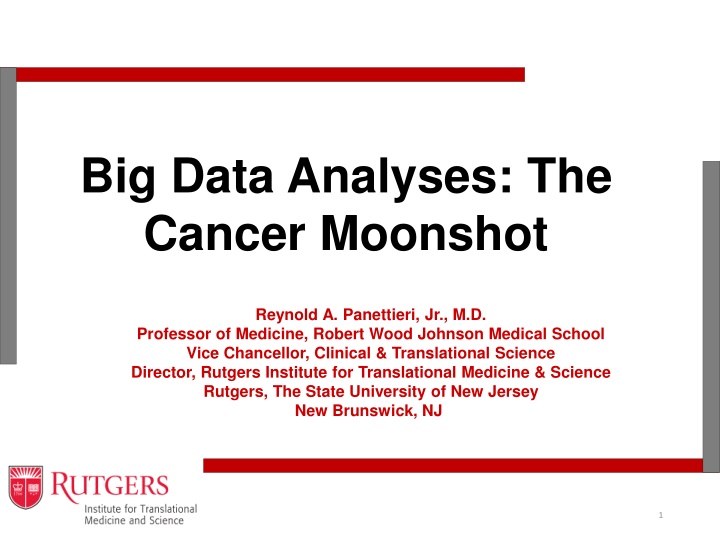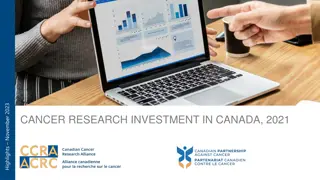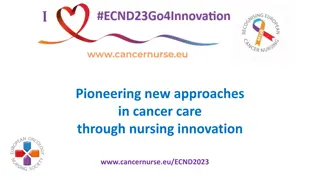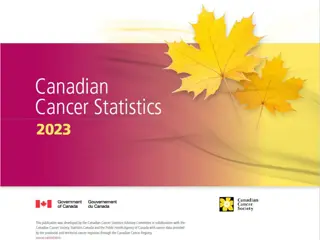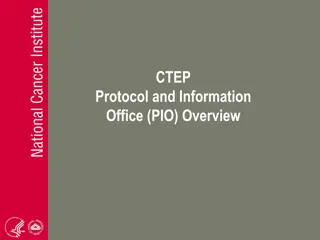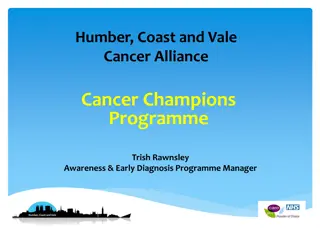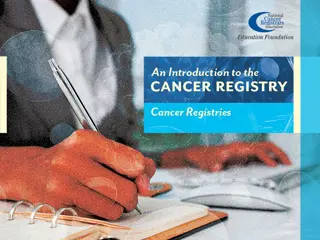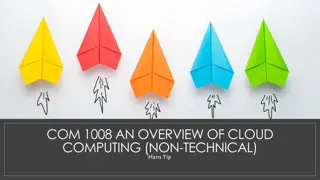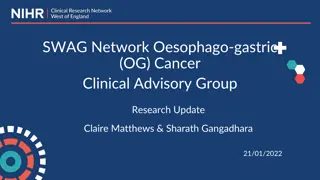Big Data Analyses: The Cancer Moonshot
Doctors have always aimed to tailor treatments to individuals, but the vision of precise cancer cures and personalized care is now becoming a reality through Precision Medicine. By harnessing big data analyses and understanding disease heterogeneity, this approach empowers patients, researchers, and providers to collaborate towards individualized care. Precision Medicine is enabling a new era of medicine through research, technology, and policies, paving the way for personalized healthcare.
Download Presentation

Please find below an Image/Link to download the presentation.
The content on the website is provided AS IS for your information and personal use only. It may not be sold, licensed, or shared on other websites without obtaining consent from the author.If you encounter any issues during the download, it is possible that the publisher has removed the file from their server.
You are allowed to download the files provided on this website for personal or commercial use, subject to the condition that they are used lawfully. All files are the property of their respective owners.
The content on the website is provided AS IS for your information and personal use only. It may not be sold, licensed, or shared on other websites without obtaining consent from the author.
E N D
Presentation Transcript
Big Data Analyses: The Cancer Moonshot Reynold A. Panettieri, Jr., M.D. Professor of Medicine, Robert Wood Johnson Medical School Vice Chancellor, Clinical & Translational Science Director, Rutgers Institute for Translational Medicine & Science Rutgers, The State University of New Jersey New Brunswick, NJ 1
Doctors have always recognized that every patient is unique, and doctors have always tried to tailor their treatments as best they can to individuals. You can match a blood transfusion to a blood type that was an important discovery. What if matching a cancer cure to our genetic code was just as easy, just as standard? What if figuring out the right dose of medicine was as simple as taking our temperature? - President Obama, January 30, 2015 2
Precision Medicine Mission Statement: To enable a new era of medicine through research, technology, and policies that empower patients, researchers, and providers to work together toward development of individualized care. 3
Heterogeneity in Disease and Response to Therapy Jamison JL et al NEJM 2015 4
Heterogeneity in Disease and Response to Therapy Jamison JL et al NEJM 2015 5
Examples of Precision Medicine Use Medical Field Disease Biomarker Intervention Cancer Chronic Myeloid Leukemia BCR-ABL Imatinib Hematology Thrombosis Factor V Leiden prothrombotics Avoid Infectious disease HIV/AIDS CD4+ T cells Highly active viral load antiretroviral therapy Cardiovascular disease CAD CYP2C19 Neurology Autoimmune encephalitis Psychiatry Alcohol-use disorder Pharmacogenomics Smoking cessation CYP2A6 Clopidogrel CXCL13 Immunotherapy GRIK1 Topiramate Varenicline 6
Precision Medicine For Practitioners Precision Medicine For Practitioners The Right Diagnosis The Right Patient The Right Therapy The Right Time Institute for Translational Medicine and Science Paving the Way For Personalized Medicine. Food and Drug Administraition (FDA) Report. October 2013. http://www.fda.gov/downloads/ScienceResearch/SpecialTopics/PersonalizedMedicine/UCM372421.pdf. March 8, 2016 7
National Cancer Moonshot Initiative National Cancer Moonshot Initiative The National Cancer Moonshot Initiative was established to accelerate cancer research, to make more therapies available to more patients, and to improve our ability to prevent cancer and detect it an early stage Community input is critical to the success of the National Cancer Moonshot Initiative, and NIH is asking the community to submit their scientific ideas or suggestion for addressing cancer research challenges to cancerreseaarch@nih.gov (closes July 1) The NCI Blue Ribbon Panel of experts will use the information submitted to help shape discussions on the cancer research priorities to be supported. The FY2017 President s budge request includes $680 million of additional funding for NCI to support the this national cancer research initiative and a $260.5 million increase in NCI funding in its FY2016 appropriation Institute for Translational Medicine and Science 8
Cancer Moonshot: Panel Recommendations 1. Establish a network for direct patient involvement. 2. Create a clinical trials network devoted exclusively to immunotherapy. 3. Develop ways to overcome cancer s resistance to therapy. 4. Build a national cancer data ecosystem. 5. Intensify research on the major drivers of childhood cancers. 6. Minimize cancer treatment s debilitating side effects. 7. Expand use of proven cancer prevention and early detection strategies. 8. Mine past patient data to predict future patient outcomes. 9. Develop a 3-D cancer atlas. 10.Develop new cancer technologies Updated from NCI: September 7, 2016 9
Cancer Moonshot: Discussions 1. Big data analyses provide impressive promissory notes. Will these analyses provide cost effective platforms to improve precision medicine approaches in cancer? 2. Challenges exist in addressing missing information and double counting participant data. If there exists no master list of participants/subjects/patients, what approaches are most valued in addressing such concerns related to cancer? Updated from NCI: September 7, 2016 10
Cancer Moonshot: Discussions (cont) 3. How may a health provider organization initiate studies if there exists no data warehouse for their data? What are the personnel and hardware needs if one wants to initiate such studies? 4. Centralized consenting is important to protect PHI (Protected Health Information). How do investigators, institutions, payers and government address the use of legacy data in cancer, especially if the subject/participant is deceased or inaccessible? Updated from NCI: September 7, 2016 11
